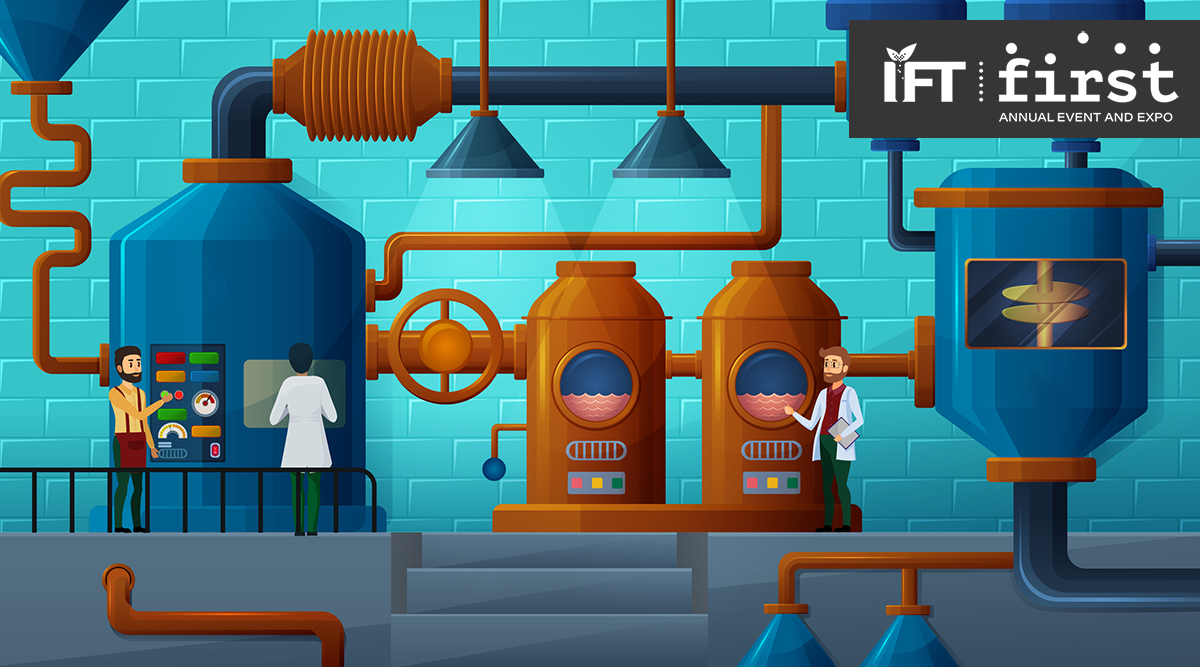Precision Fermentation Among Innovations to Prepare for Next Crisis
In one of Monday’s Scientific & Technical Forums experts discussed what innovations will help to prepare the food-chain ecosystem for the next crisis.

What innovations will help to prepare the food-chain ecosystem for the next crisis, whether it’s related to global climate change, a pandemic, war, or something else? Panelists at a Scientific & Technical Forum on Monday at IFT FIRST covered a range of such scenarios, including Justin Shimek, CEO and chief technology officer at Mattson & Co., who offered a pre-recorded session on “Product Design and Development with Precision Fermented Ingredients.”
Precision fermentation uses genetic engineering to specifically “tune” microorganisms to produce granular, functional ingredient endpoints, Shimek said. “Those endpoints can be everything from very specific enzymes, to amino acids and vitamins, which are the building blocks of nutrition, to very specific proteins and fats,” he said.
The process starts with trying to figure out, precisely, what molecule you’re trying to create, and what the business case might be, Shimek said. Next comes the development and engineering of microbial strains to be able to efficiently produce the feedstocks, and then finally figuring out how to scale up output.
All of this involves “figuring out, really, what are the best applications, and then hopefully influencing their ability to further design and refine their products, making them better in an iterative way,” he said. “So, some of this is the domain of food scientists, in terms of application and formulation, but also working very closely with engineers and bioprocess specialists.”
Companies need to think through the regulatory and related food safety aspects—and realize that during scale-up, there can be “lot-to-lot variability that needs to be taken into account, as well as changes in downstream processing,” he said. “For example, when something is produced at the lab level, often it will be freeze-dried—but perhaps on an industrial-level transition, spray-dried. So, all of those things need to be taken into account.”
Mattson performs SWOT [strengths-weaknesses-opportunities-threats] analyses for its clients, taking into account both the internal properties of the potential ingredients but also the external aspects of the environment, Shimek said. “We encourage clients to think broadly about the opportunities, and also the competitive landscape in which they’re operating,” he said. “We’re looking for opportunities, … iterating quickly, and then developing out applications.”
Mattson’s research has shown precision fermentation products need to be explained to consumers in a nuanced way that gets across their taste, most importantly, along with the impacts on health and the environment, and consumer safety, Shimek explained. “There’s plenty of opportunities for marketers and developers because there are still significant gaps between the importance and the believability of some of these top drivers,” he said.
During the discussion on Monday, Shimek noted that the term “precision fermentation” is more science-oriented than consumer-facing. “We don’t yet have adequate nomenclature to talk to consumers,” he said. “A lot of times, they don’t want to know how the sausage is made—the proverbial sausage or the real sausage.”
Such messaging needs to address more than one bottom line, said fellow panelist Dilek Uzunalioglu, senior director, food discovery and design at Motif FoodWorks. “We’re doing it because we want to make food that tastes similar to what you are already eating, but also you are saving the planet,” she said. “You need to educate [consumers], talk about the technology and its benefit.”
Policymakers and potential funders also need to be educated, Uzunalioglu said. “We need to do a better job as the food community,” she said. “Food has a big impact on climate change. A lot of research funding goes to food safety. I’m not saying that isn’t important. But we need to push for funding for other technologies as well.”
Scientific & Technical Forum co-host Renske Janssen, project manager, protein technology at NIZO Food Research, said the session provided a rich discussion with a variety of interesting points of view. “We need those innovations to transform our food system,” she said. In addition to new technologies, “We can use existing methods in new ways, keeping in mind, what does the consumer want, and what does the consumer need?”
The Scientific & Technical Forums are conversations that bring together science of food experts to address 25 guiding questions. All the conversations will be accompanied by pre-recorded presentations by the experts that delve deeper into specific scientific elements within the science of food and are focused on different disciplines and topics. These recordings will be available to all IFT FIRST attendees after the event.
Food Technology Articles

Future Food-Tech 2024 Tackles Transformation, Underscores Collaboration
Mission-driven Future Food-Tech exhibitors and conference presenters showcased innovative, transformative ingredients and technologies and emphasized the importance of collaboration in addressing food system challenges.

Adapting to Change: Insights From the RCA Conference
An overview of insights shared at the Research Chefs Association (RCA) Annual Conference & Culinology Expo in Quincy, Mass.

Mealworm Production Plant in Advances, New Ingredients, and More
A roundup of news from food industry suppliers.

New Growth Factor Facility Opens and More Ingredient News
A roundup of news from food industry suppliers.

Good-for-You Products Are Healthy Investments for VC Funds
Stray Dog Capital partner Johnny Ream shares his investment philosophies, including his focus on using the food system to help improve public health.
Recent Brain Food

A New Day at the FDA
IFT weighs in on the agency’s future in the wake of the Reagan-Udall Report and FDA Commissioner Califf’s response.
Members Say IFT Offers Everything You Need to Prepare for an Uncertain Future
Learn how IFT boosts connections, efficiencies, and inspiration for its members.

More on the FDA's Food Traceability Final Rule
In a new white paper, our experts examine the FDA’s Food Traceability Final Rule implications—and its novel concepts first proposed by IFT.
Job Satisfaction in the Science of Food is High but Hindered by Pain Points
IFT’s 2022 Compensation and Career Path Report breaks it down.
